#computationaltheory
Explore tagged Tumblr posts
Text
"Introduction to the Theory of Computation" by Michael Sipser is a foundational textbook that explores the mathematical underpinnings of computer science. By reading this book, you will gain a deep understanding of computation, its limits, and its capabilities. Below is a step-by-step breakdown of the outcomes you can expect from studying this book:
#TheoryOfComputation#ComputationTheory#ComputerScience#Algorithms#FormalLanguages#AutomataTheory#CSBooks#TechBooks#ComputationalTheory#TuringMachines#ComputationalComplexity#DataStructures#TechEducation#SoftwareEngineering#MathematicalLogic#TheoryOfComputationBooks#TechTutorial#ComputerScienceTheory#Programming#CSTheory#ComplexityTheory#MachineLearning#DiscreteMathematics#FormalMethods
0 notes
Text
Uncanny Dimple
My final project Uncanny Dimple is a body of work that examines the close proximity between the cute and the creepy. Drawing from roboticist Masahiro Mori’s concept of the Uncanny Valley, which explains the eeriness of lifelike robots, my theory of the Uncanny Dimple portrays a parallel phenomenon in the context of cuteness. The robotic creatures inhabiting the dimple demonstrate the often contradictory affects we experience towards non-human actors. When does cuteness start to border on the grotesque? If cuteness is the outcome of extreme objectification of living beings, can it also be the result of an anthropomorphising inanimate objects? Why does cuteness trigger the impulse to nurture and to protect, but also to abuse and to violate? Cute things are often seen as innocent, passive, and submissive, but can they also manipulate, misbehave and demand attention?
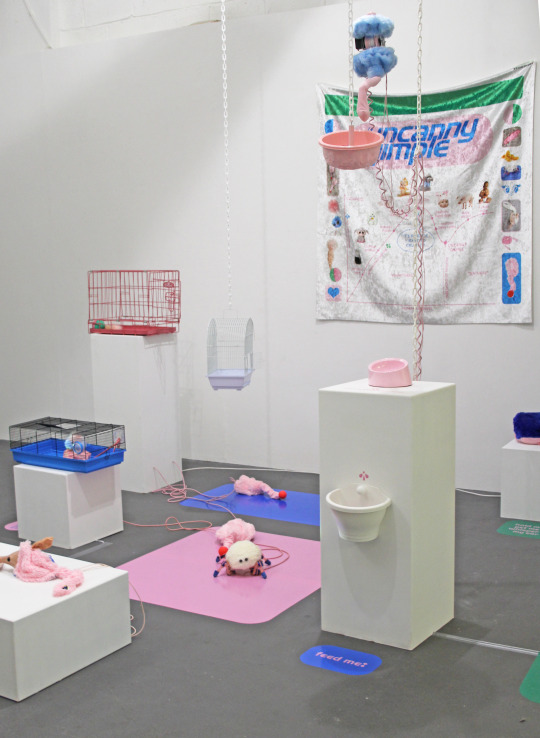
This body of work is based on my MFA thesis Uncanny Dimple — Mapping the Cute and the Uncanny in Human-Robot Interaction, where I examine the aforementioned contradictions of cuteness by applying Donna Haraway’s Cyborg Manifesto (1991) and the Uncanny Valley theory by Masahiro Mori (1970). I also reference the recent research on the cognitive phenomenon of cute aggression, a commonly experiences impulse to harm cute objects. (Aragón et al. 2015; Stavropoulos & Alba 2018)
Sigmund Freud first coined the term uncanny in his 1919 essay Das Unheimliche to describe an unsettling proximity to familiarity encountered in dolls and wax figures. However, the contemporary use of the word has been inflated by the concept of the Uncanny Valley by roboticist Masahiro Mori. Mori’s notion was that lifelike but not quite living beings, such as anthropomorphic robots, trigger a strong sense of uneasiness in the viewer. When plotting experienced familiarity against human likeness, the curve dips into a steep recess — the so called Uncanny Valley — just before reaching true human resemblance.
As a rejection of rigid boundaries between “human”, “animal” and “machine”, Haraway’s cyborg theory touches many of the same points as Mori’s Uncanny Valley. Haraway addresses multiple persistent dichotomies which function as systems of domination against the “other” while mirroring the “self”, much like cuteness and uncanniness: “Chief among these troubling dualisms are self/other, mind/body, culture/nature, male/female, civilized/primitive, reality/appearance, whole/part, agent/resource, maker/made, active/passive, right/wrong, truth/illusion, total/partial, God/man.” (Haraway 1991: 59)
Haraway’s image of the cyborg, despite functioning more as a charged metaphor than an actual comment on the technology, still aptly demonstrates the dualistic nature of cuteness and its entanglements with the uncanny at the site of human-robot interaction. Furthermore, Haraway’s cyborg theory grounds the analysis of the cute to a wider socio-political context of feminist studies. In the Companion Species Manifesto where she updates her cyborg theory, Haraway (2003: 7) is adamantly reluctant to address cuteness as a potential source of emancipation (which seems to be the case with other feminists of the same generation): "None of this work is about finding sweet and nice — 'feminine' — worlds and knowledges free of the ravages and productivities of power. Rather, feminist inquiry is about understanding how things work, who is in the action, what might he possible, and how worldly actors might somehow be accountable to and love each other less violently." I argue on the contrary that some of these inquiries can be answered by exposing the potential of cuteness as a social and moral activator. While Haraway describes a false dichotomy between these “sweet and nice” worlds and “the ravages and productivities of power”, I believe that their entanglement is in fact an important site for feminist inquiry. By revealing the plump underbelly of cuteness, we can harness the subversive power it wields.
In my thesis I conclude that cuteness and uncanniness are both defined by their distance to what we consider “human” or “natural”, and shaped by the distribution of power in our relationships with objects that we deem having a mind or agency. I continue to propose that a similar phenomenon to the Uncanny Valley can be described in regard of cuteness, which I call the Uncanny Dimple. Much like Mori’s valley and Haraway’s cyborg, Uncanny Dimple is presented as a figuration: It does not necessarily try to make any empirical or quantitative claims about the experience of cuteness, but strives to utilise the diagram as a rhetorical device for better understanding the entangled affects of cuteness and uncanniness.
Similar to Mori’s visualisation of the Uncanny Valley, the Uncanny Dimple is mapped in a diagram where the horizontal axis denotes “human likeness”, but Mori’s vertical axis of “familiarity” is in this case replaced with cuteness. Similar to Mori, I propose that cuteness first increases proportionally with anthropomorphic features. As established in Konrad Lorenz’s Baby Schema model from 1943, cuteness also increase proportionally in the presence of neotenic (i.e. “babylike”) features, such as large eyes, tall forehead, chubby cheeks and small nose. I suggest that this applies only to some extent: When the neotenic features have reached a point where they are over-exaggerated beyond realism, but the total human likeness is still below the Threshold of Realism, cuteness climaxes at what I call the Cute Aggression Peak. When human likeness exceeds that point, cute aggression becomes unbearable, the experienced cuteness is surpassed by uncanniness, and the curve dips to the Uncanny Dimple.

I wanted to create various cute but uncanny creatures which all had their distinctive way of moving or interacting with the audience. I created multiple different prototypes of most of the creatures, and in the final installation I had eight different types:
1. Sebastian is an interactive quadruped robot that can detect obstacles. Sebastian will wake up if it's approaced, and run away. The inverse kinematic functions for the quadruped gait are based on SunFounder's remote controlled robot. In the basic quadruped gait three legs are on the ground while one leg is moving. The algorithm calculates the angles for every joint in every leg at every given time, so that the centre of gravity of the robot stays inside the triangle of the three supporting legs. I designed all the parts and implemented the new dimensions in the code. I also added the ultrasonic sensor triggering and obstacle detection. For calculating distance measurements based on the ultrasonic sensor readings I used the New Ping library by Tim Eckel.
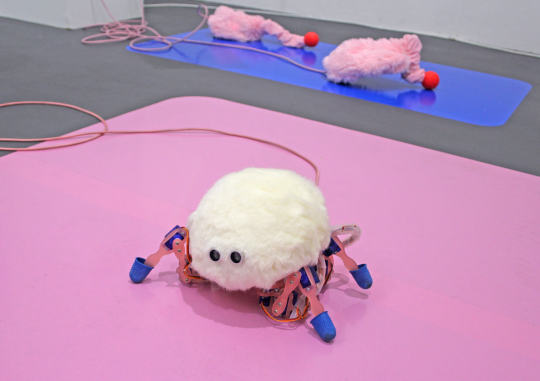
2. Ritu is an interactive robotic installation using Arduino, various sensors, servo motors and electromagnet. Users are prompted to feed the vertically suspended robot, which will descend, pick the treat from the bowl, and take it up to its nest. There is a hidden light sensor in the bowl, which senses if food is placed in the bowl. This will trigger the robot to descend using a continous rotation servo motor winch. The distance the robot moves vertically is based on the reading of a ultrasonic sensor. The robot uses an electromagnet attached to a moving arm to pick up objects from the bowl. After succesfully grabbing the object, the robot will ascend and drop the object in a suspended nest. For calculating distance measurements based on the ultrasonic sensor readings I used the New Ping library by Tim Eckel.
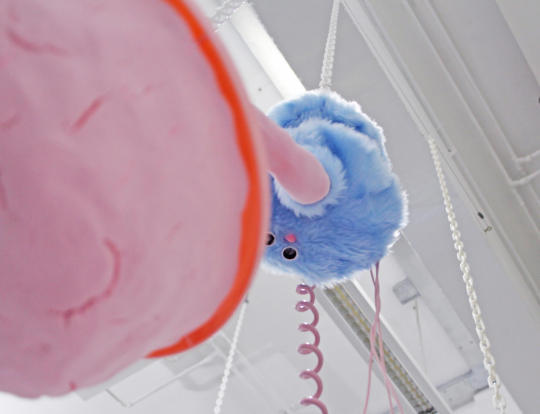
3. Crawler Bois are two monopod robots that move with motorised crawling legs that mimic the mechanism of real muscles and tendons. Each robot has a leg that consist of two joints, two servo motors, a string, and two rubber bands. The first servo lifts and lowers the leg, and the second servo tightens the string (the "muscle") which contracts the joins. When the string relaxes, the rubber bands (the "tendons") pull the joints to their original position. The robots move back and forth in a randomised sequence and sometimes do a small dance.
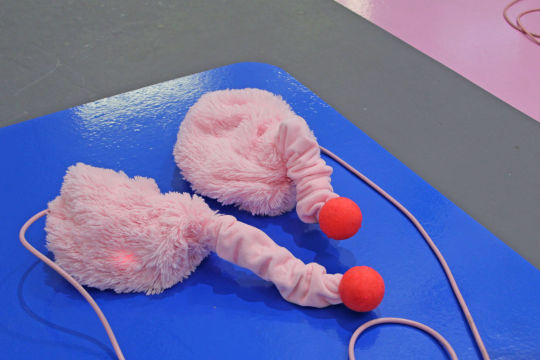
4. Lickers are three individually interactive robots using servo motors, Scotch Yoke mechanisms, and sound sensors. The Scotch Yoke is a reciprocating motion mechanism, in this case converting the rotational motion of a 360 degree servo motor into the linear motion of a licking silicone tongue protruding from the mouth of a creature. If a loud sound is detected, the creature will stop licking and lift up its ears. The treshold of the sound detection can be modified directly from a potentiometer on the sound sensor module.
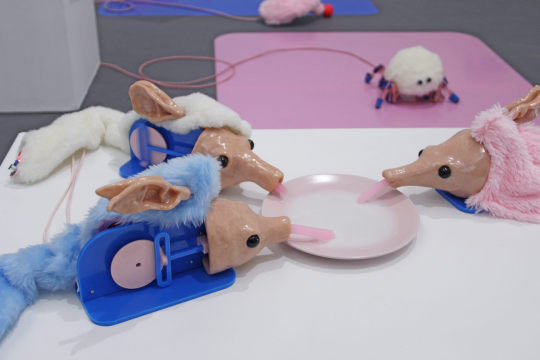
5. Shaking Little Critter is a simple interactive installation using an Arduino, a vibrating motor and a light sensor. Users are prompted to remove the creature's hat, after which it will "get cold" and start shaking around in its cage. The absence of the hat is detected with a light sensor on top of the creature's head.
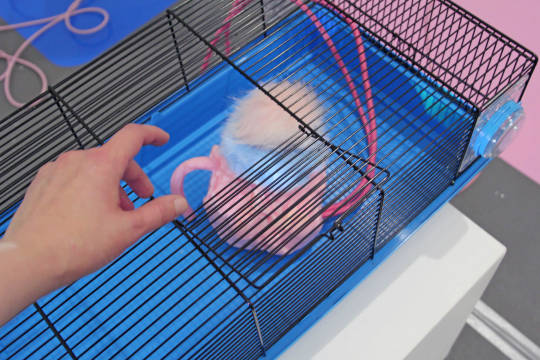
6. Rat Queen is a robotic installation exploring the emergent features arising from the combination of pseudo-randomness and mechanic inaccuracy. It consist of five identical rats-like robots that are connected to a shared power supply with their tails. All the members of the Rat Queen move independently in randomised sequences, but because they are started at the same time, the randomness is identical, since the random seed is calculated based on the starting time of the program. However, due to small inaccuracies and differences in the continuous rotation servo motors and their installation, the movement patterns diverge, and the rats slowly get increasingly tangled with their tails.
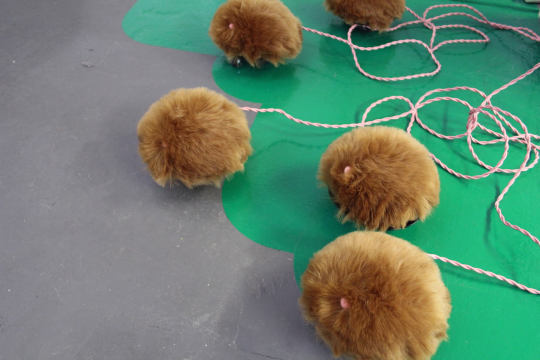
7. Cute Aggression is an interactive sound installation using Arduino and Max MSP. Users can record sounds by whispering in a hidden microphone in the plush toy creature's ear. A tilt switch in the ear starts the recording when the ear is lifted. The sounds are played back when the user pets the creature. The petting is detected with conductive fabric using Capacitive sensing library by Paul Badger. The reading from the sensor is sent to a Max MSP patch via serial communication. The sounds a generated from the Arduino data using a granular synthesis method based on Nobuyasu Sakonda’s SugarSynth. Sounds can be modulated by manipulating the creature's nipples, which are silicone-covered potentiometers.
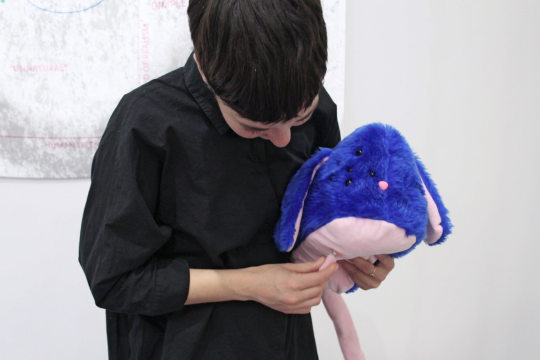
8. Cucumber Weasel is a modified version of the motorised toy know as weasel ball. The plastic ball has a weighted, rotating motor inside, which makes the ball roll and change directions. The toy usually has a furry “weasel” attached to it, but here it is replaced with a silicone cast of a cucumber.
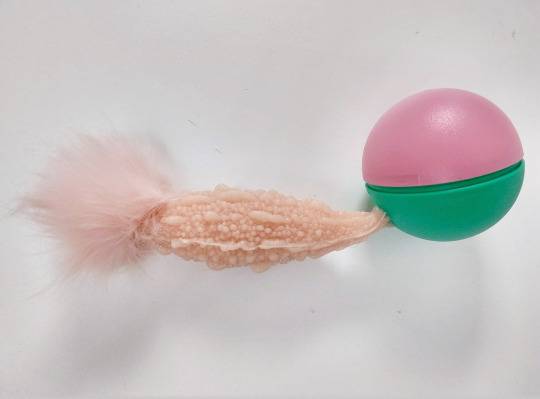
References:
Aragón, O. R; Clark, M. S.; Dyer, R. L. & Bargh, J. A. (2015). “Dimorphous Expressions of Positive Emotion: Displays of Both Care and Aggression in Response to Cute Stimuli”. Psychological Science 26(3) pp. 259–273.
Badger, P. (2008). Capacitive sensing library.
Eckel, T. (2017). New Ping library for ultrasonic sensor.
Freud, S. (1919). The ‘Uncanny’. The Standard Edition of the Complete Psychological Works of Sigmund Freud, Volume XVII (1917-1919): An Infantile Neurosis and Other Works, pp. 217-256.
Haraway, D. (1991). "A Cyborg Manifesto: Science, Technology, and Socialist-Feminism in the Late Twentieth Century," in Simians, Cyborgs and Women: The Reinvention of Nature. New York, NY: Routledge.
Haraway, D. (2003). The Companion Species Manifesto: Dogs, People, and Significant Otherness. Chicago, IL: Prickly Paradigm Press.
Lorenz, K. (1943). “Die angeborenen Formen moeglicher Erfahrung”. Z Tierpsychol., 5, pp. 235–409.
Mori, M. (2012). "The Uncanny Valley". IEEE Robotics & Automation Magazine, 19(2), pp. 98–100.
Rutanen, E. (2019). Uncanny Dimple — Mapping the Cute and the Uncanny in Human-Robot Interaction.
Sakonda, N. (2011). SugarSynth.
Sunfounder (n.d.). Crawling Quadruped Robot Kit v2.0.
Stavropoulos K. M. & Alba L. A. (2018). “‘It’s so Cute I Could Crush It!’: Understanding Neural Mechanisms of Cute Aggression”. Frontiers in Behavioral Neuroscience, 12, pp. 300
1 note
·
View note
Text
Final Exhibition Progress
The project grew quite organically in the span of eight months since I didn’t have a clear idea how many or what kind of robots I wanted to create when I started. I quite enjoyed working in a way that allowed me to quickly jump from one prototype to another, constantly coming up with new ideas for interesting mechanisms or interactions. However this meant that some of the creatures were not developed as far as I would have wanted, since I more or less ended up choosing quantity over quality in some cases. Especially the interactive sound plushie, which was one of the first creatures I started developing, didn’t quite evolve past the first prototype phase because I constantly got carried away with new ideas. In the future I would definitely want to develop it further, probably in the form of a sound performance as I originally intended.
On the other hand, having multiple individual robots meant that there wasn’t going to be a single point of failure that would impair the entire installation. When one robot was malfunctioning (which they obviously did) I could simply take it aside without much effect to the overall experience. Nevertheless, one major area of improvement would be to make the robots more robust, so that they could actually run for multiple days without needing any parts replaced. Most breakdowns however were mainly due to using servo motors with plastic gears, since they were less expensive and more readily available.
Also having so many different features in one project forced me to streamline the technologies to the minimum, which ended up working to my benefit: I was pleasantly surprised how very simple means — just couple of servo motors and sensors — I needed to create as varied and engaging interactions. For example, I planned using a complex computer vision system for detecting the food placed in the bowl below Ritu, but ended up developing a much more simple, elegant and failsafe solution by placing a hidden light sensor in the bowl.
From the perspective of my theoretical research, I felt that my work was able to communicate my thesis of the Uncanny Dimple to the audience. In addition, I’m satisfied how approachable the work was for everyone: It was great to see how adults, small children and dogs alike were interested in interacting with the creatures.
I also enjoyed creating work within my own aesthetic and affective category of the Uncanny Dimple, since it allowed me to take on various different diversions and new skills, such as more complex robotics and Max MSP, but it was also constrictive enough to create a unified body of work. I still have plenty of unused ideas and sketches left for robots I didn’t have time to execute, which proves that this body of work is something I definitely would want to expand in the future.



0 notes
Text
Solo show: Uncanny Dimple
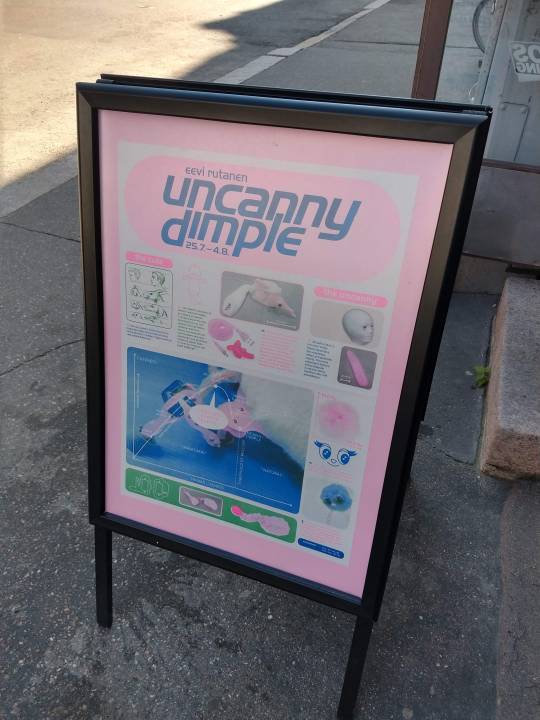
I had my first solo show Uncanny Dimple at Kosminen gallery in Helsinki from 25 July to 4 August. It was a good opportunity to show my final project before September’s degree show, and to see what works in an exhibition setting and what doesn’t. Overall I think the show was a great success: The opening was buzzing, and the feedback I got was overwhelmingly positive. I even got some coverage on national news.
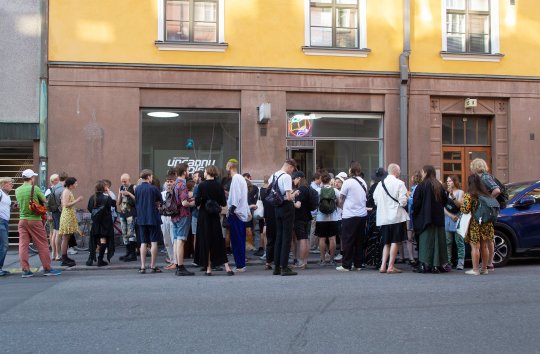
Even though the contemporary art scene in Helsinki is quite vibrant, I still feel that computational arts is a relatively unknown field. It was great to see how much interest there was for robotic artworks, and how many passers-by did a double take and decided to visit the gallery.
I also printed my MFA thesis as a small zine which I sold at the exhibition. To my surprise, I sold all the 50 copies I had.

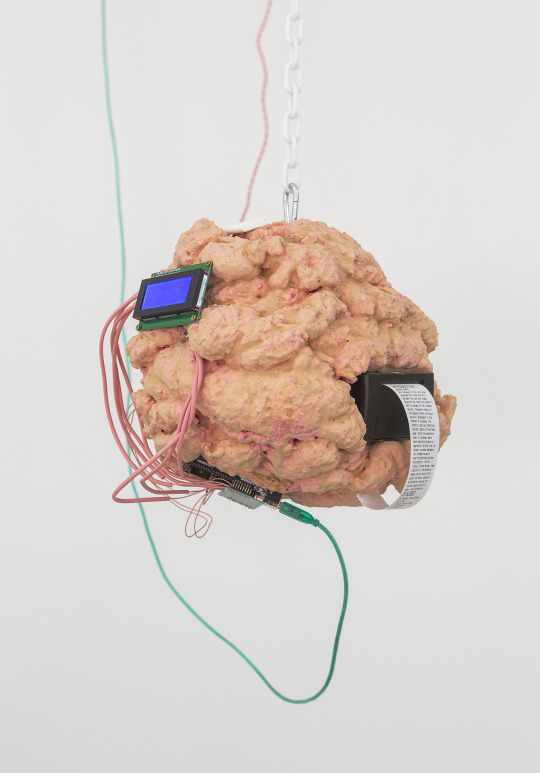
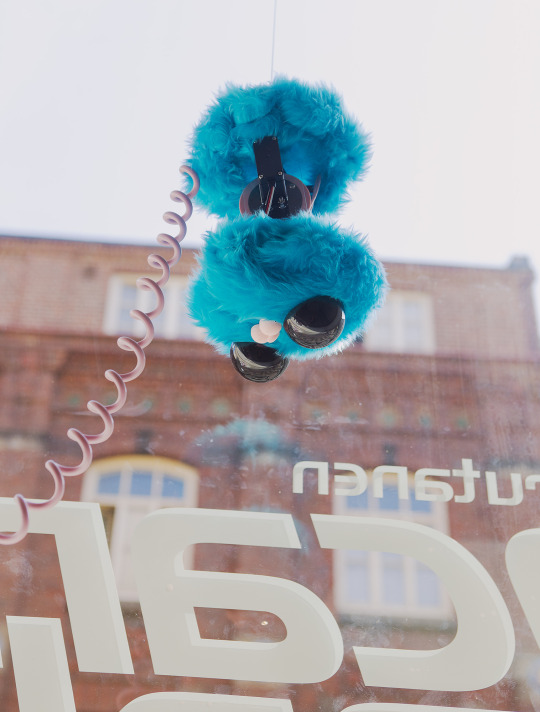
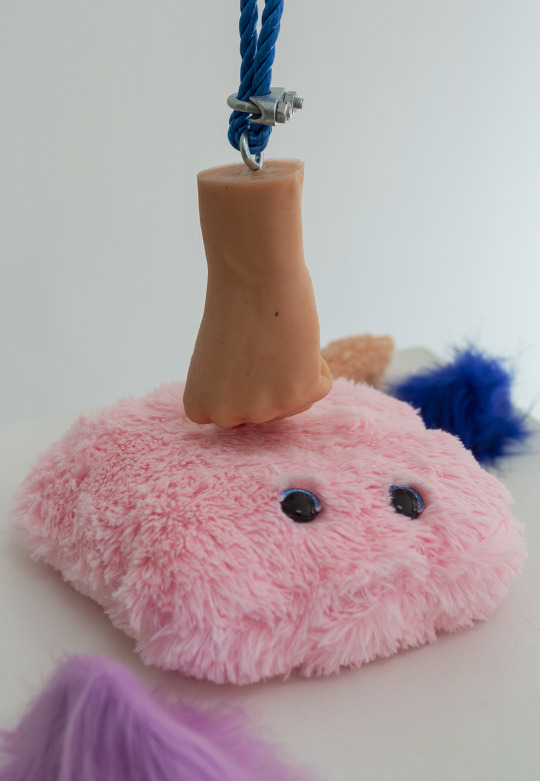
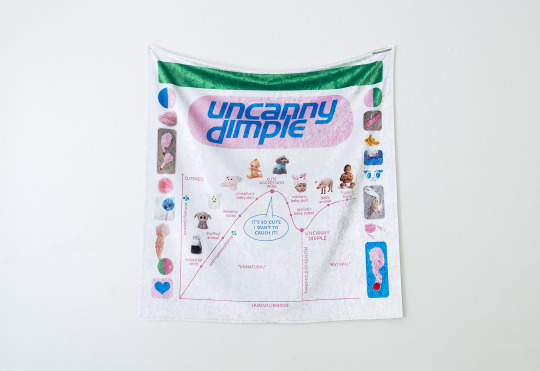
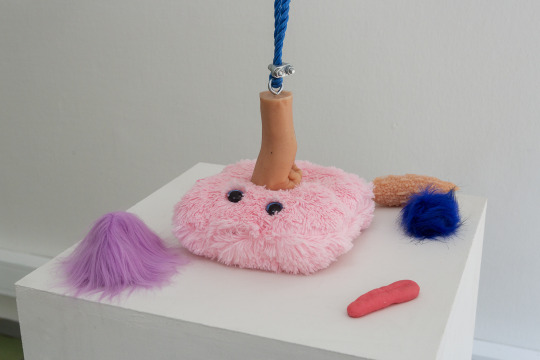

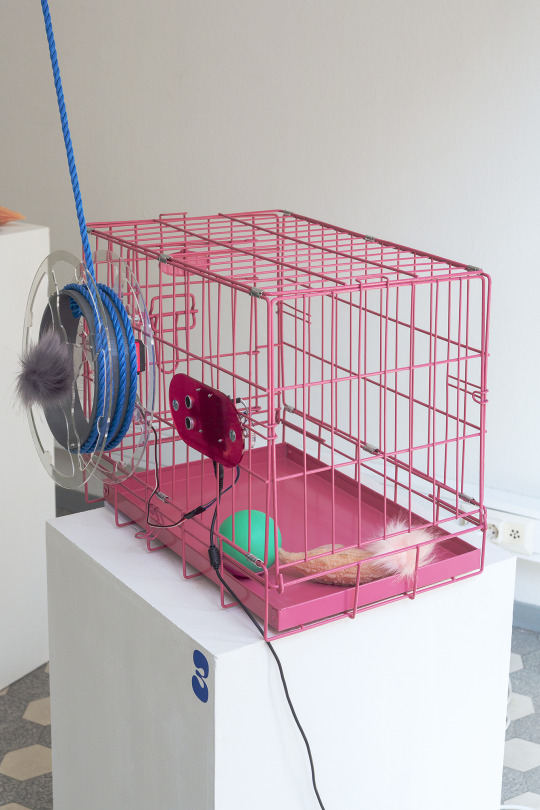

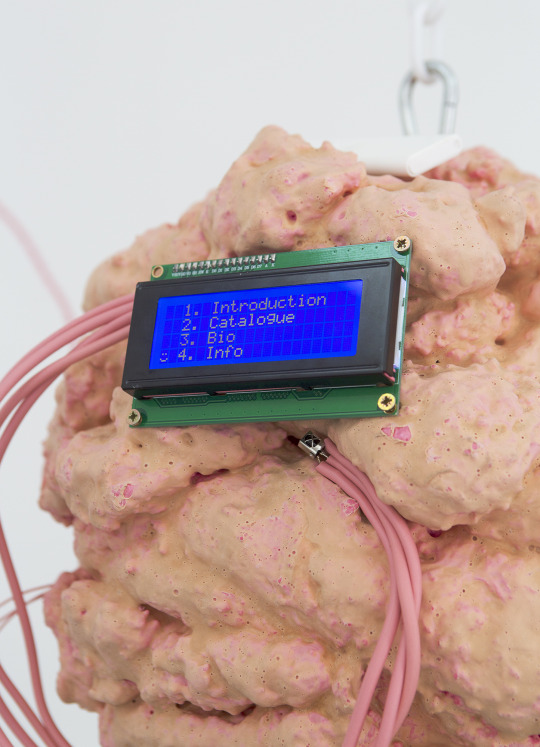
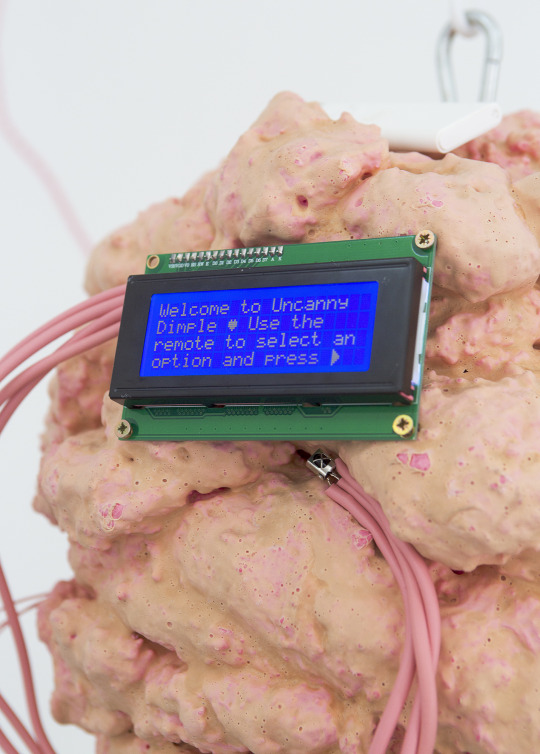
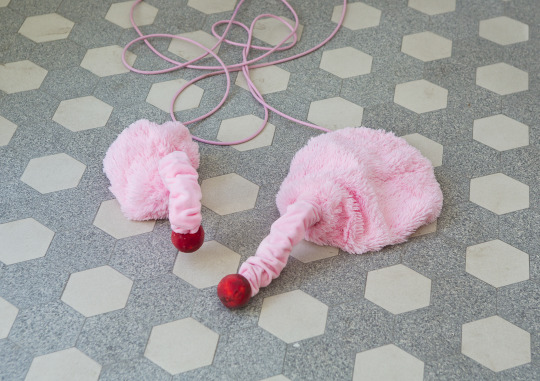
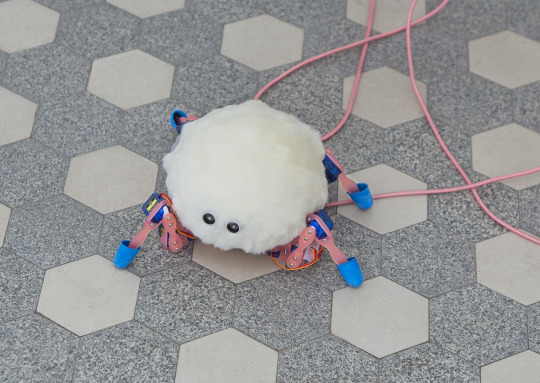

0 notes
Text
Developing a Crawl
While creating the animatronic “leg” for the creepy fetus-creature in the GRASPER installation, I became interested in different ways of locomotion this type of appendage would allow. I wanted to mimic the functionality of the muscular foot that clams and molluscs use for movement, so I started to research various types of robotic joints and artificial muscles.
youtube
I developed a mechanism that was inspired by various simple robot hand tutorials available online, which imitates (in a very rudimentary way) the mechanism of biological muscles and tendons.
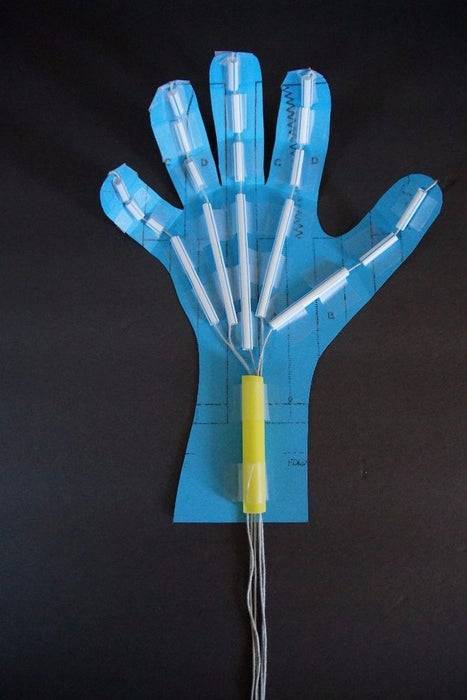
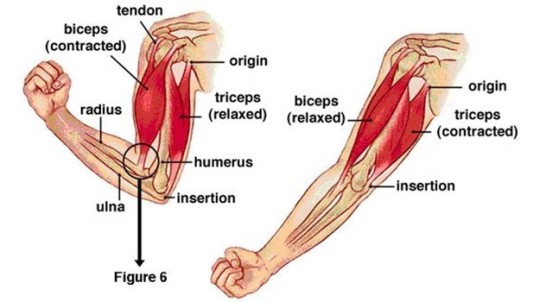
The mechanism consists of two servo motors, one which lifts the leg, and other that tightens the cord which flexes the joints. When the cord is released, the rubber bands on the opposite side will contract the leg to its original state.
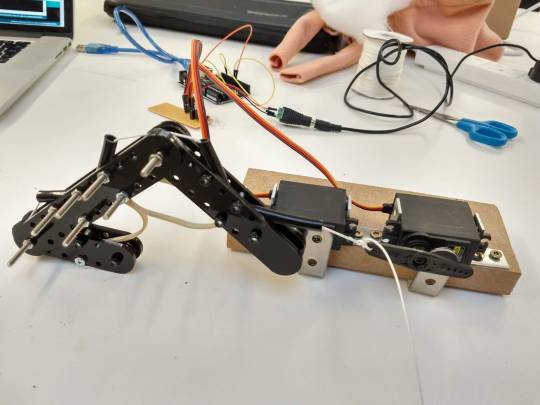
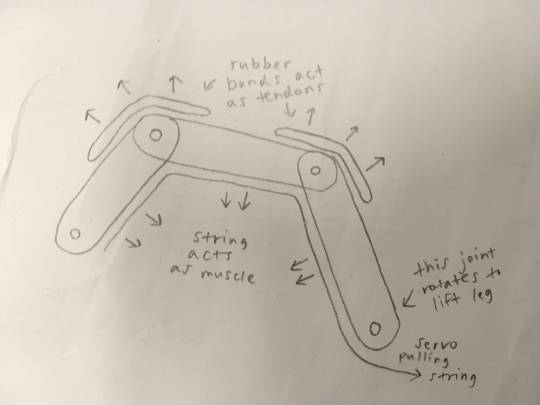
Plenty of fine-tuning was required to accomplish an actual forward motion where the leg can pull the weight of the entire mechanism: The tightness of the cord and the rubber bands, the angle of the joints and the timing of contraction and elevation all affected the movement in complex ways. I also had to add a styrofoam ball coated with latex to the tip of the foot to help with traction.
View this post on Instagram
A post shared by Eevi Rutanen (@eebiru) on Mar 21, 2019 at 7:48am PDT
0 notes
Text
Term 2 Project Proposal
Computational Arts-based Research and Theory
What is the overarching area of research?
Dan McQuillan describes how predictions made by machine learning algorithms are becoming a self-fulfilling form of governance. Despite the fact that we can’t fully understand how deep learning neural networks work, we trust them to make decisions with material consequences of varying severity. This blind trust on the presumed objectivity of data science, the following “abstraction of accountability” (McQuillan), and the confusion between correlation and causation can lead to policies that are biased, totalising and extra-judicial but justified by law.
Biases and prejudices do not occur in machine learning algorithms spontaneously, but are infected via the data sets that are used in the training of said algorithms. In my research project I want to expose the discriminatory and biased nature of data sets used in machine learning, focusing on ImageNet and WordNet databases, which are among the largest and most used open data sources for deep learning.
In my research project I wish to suggest countermeasures against the algorithmic pre-empting of the future and the biased knowledge claims of prevailing data science methods. Drawing from feminist perspectives on science and speculative research methodologies, I wish to propose alternative epistemologies that are more situated, embodied, participatory, pluralistic and nomadic than the hegemonic knowledge production.
I will visualise these expositions and inquiries in the form of an interactive web application that invites people to a participatory creation of alternative machine learning data sets.
What are the key questions or queries you will address?
How do biased data sets affect the knowledge production of contemporary machine learning algorithms? What is situated knowledge like and how can it be produced? How to produce knowledge outside the hegemonic epistemology?
Why are you motivated to undertake this project?
In my opinion, a computational dystopia is not about a totalitarian regime of hostile AIs, but a discriminatory algorithmic governance infected by human bias and prejudice. Signs of such governance are already detectable, so I think there is an urgent need for countermeasures and alternative approaches.
What theoretical frameworks will you use in your work to guide you?
—Feminist technoscience, e.g. situated knowledge, standpoint theory, agential realism —Speculative realism, speculative research methodology

Image: Imagenet database
Related papers & articles
—Dan McQuillan: Algorithmic states of exception —Dan McQuillan: Data Science as Machinic Neoplatonism —Donna Haraway: Situated knowledges: The science question in feminism and the privilege of partial perspectives. In Simians, cyborgs and women. —Karen Barad: Getting Real: Technoscientific Practices and the Materialization of Reality. —Stanford Encyclopedia of Philosophy: Feminist Perspectives on Science. —Alex Wilkie, Martin Savransky, Marsha Rosengarten: Speculative Research: The Lure of Possible Futures —Steven Shaviro: The Universe of Things: On Speculative Realism —Gilles Deleuze & Felix Guattari: Nomadology: The War Machine —ImageNet & WordNet databases
0 notes
Text
Walkthrough Method
The walkthrough method is an approach for examining the sociocultural underpinnings of a software application by systematically and critically analysing the app’s interface, infrastructure and interactions. Theoretically based on science and technology studies and cultural studies, the walkthrough method implements the principles of Actor-Network Theory by recognising how technologies shape cultural discourses while simultaneously being products of those discourses.
The method is implemented with following steps:
1. Examining the “environment of expected use” This comprises of all the relevant information about how the app’s creators expect the app to be used, operated and governed, including the app’s target base, user scenarios, business strategy, revenue sources, and regulation and management of users. To discover this information the researcher should investigate material also outside the app itself. This includes for example the material about the application on app stores, the app’s website, marketing material, press releases, public statements of the creators, terms of service documents, market information, etc.
2. Performing the technical walkthrough of the app The researcher simulates user behaviour by engaging with the app’s interface in a typical user scenario, including registration, accessing different features of the app, and terminating the use. The researcher traces and documents key actors in the app’s interface, such as buttons, menus, prompts, textual content and visual representations. Applying the Actor-Network Theory, the researcher assesses how these actors convey and transform meaning through the interactions they invoke, and what embedded cultural discourses and references they communicate.
3. Assessing evidence of unexpected practices After examining the intended user scenario, the researcher should investigate how these intentions can be resisted with unexpected use of the app. This can include utilising third-party services, hacking the app’s functionalities, or other user-led activities regarding the app, such as sharing tips or critique in social media.
Performing the Walkthrough Method: Legal Fling
Vision
The app is meant for recording sexual consent in a legally binding agreement verified by blockchain. Regarding the representations on the app’s website, the target base seems to be young heterosexuals who have sex with non-regular partners. The relationships displayed are mainly between men and women, and the front page prominently exhibits male and female symbols. However also the transgender symbol is shown, although smaller in size. Most representations on the website are of ethnically white people, except the example user’s contact list, which shows some ethnic diversity.
An expected user case is described on the website as follows:
During a fun night you meet your fling. Now it's time to get consent. Does your fling really want to take it further? Simply open the LegalFling app, scroll to your contacts and send a request. Your sexual preferences, including your do's and don'ts are automatically communicated. Are you into BDSM but your fling isn't? LegalFling matches sexual preferences automatically, so you're immediately aware what your fling doesn't appreciate and will not consent to. Hopefully you will not be needing this further down the road. But just in case, feel safe knowing that there is a legally binding agreement. Any violation can be dealt with quickly and privately.
This implies that the expected user is having sex with a person who is not their regular partner. “During a fun night” suggests that there might be alcohol involved. “Just in case, feel safe knowing that there is a legally binding agreement” seems to describe a scenario where the person has to prove that the sex was consensual, even if the other person claims it was not. Phrases like “Sex should be fun and safe, but nowadays a lot of things can go wrong” suggest that situations with non-explicit sexual consent are a new development, and that the user should be worried of such scenarios. They also mention the #metoo campaign on the website to emphasise the urgency and relevance of the app.
The marketing material repeatedly claims that the app is for “everyone”, but the app seems to be only useful in situations where the user needs to verify that there was consent, and not for situations where there wasn’t. However, on their website’s FAQ section the company tries to alleviate these connotations with following answers:
Are you promoting rape culture? No, on the contrary. Getting explicit consent and expressing your do's and don'ts before sex should be the norm, but it typically doesn't happen. LegalFling is a fun and clear way to set the rules before play.
Can I still change my mind? Absolutely. ‘No’ means ‘no’ at any time. Being passed out means "no" at any time. This is explicitly described in the agreement. Additionally you can withdraw consent going forward through the LegalFling app with a single tap.
Despite calling the sexual relations related to the app ‘Flings’ the user target base includes also people in long term relationships: “This app is also useful for long term Flings. You can add an infinite duration on the contract in the 'settings menu'. For a short term Fling you can limit the duration of the consent to a couple of hours.“
Operating model The website states prominently that the “showcase is powered by LiveContracts.io”, and the footer claims that the copyright of the site belongs to “LegalThings B.V. of Amsterdam, the Netherlands”. The LegalFling app is created by an Amsterdam-based company LegalThings, who’s flagship product is a service called Live Contracts. Live Contracts sells licences to the company’s technology that can be used to create and validate different legal documents using blockchain. LiveContracts are introduced on the LegalFlings website with following incentives:
LegalFling is a showcase for Live Contracts, demonstrating that an agreement doesn't have to be a 10 page document full of legal lingo that can only be enforced through lawyers. … We believe that Live Contracts can have a positive change on the world. Accomplishing this requires mass adoption. By tokenizing our license, we want to create an incentive for early adopters and a reward for the community that helps us push this technology.
A button saying “support this project” leads to the LiveContracts page. It seems that the user of the LegalFling app would have to purchase the LiveContracts tokens to create the agreements. Saying that the LegalFling app is a showcase for LiveContracts multiple times on the website seems to communicate that the app itself is not the main product of the company, but more of an publicity stunt to advertise the LiveContracts technology.
Governance
The app is not yet released, but potential users can subscribe for a mailing list on the website. The website claims that the app should have been released on Apple’s App Store an Google Play Store in the end of February 2018.
The only limitation for users is the age: “The minimum age to use the app depends on the minimum age to have sex in your country of residence.”
The privacy and security of the blockchain technology is emphasised repeatedly: “Only the transaction hash is stored and timestamped in the blockchain, so your privacy is guaranteed.”
Legal Fling suggests the app’s authority and trustworthiness in every turn, but the actual legal implications of the app might be nonexistent: The website admits that “To which extent the contract holds up in court depends on your country of residence.”
Walkthrough
I could not register as a user since the app is not yet publicly available. However the website displays the app’s features with multiple screenshots.
1. Requesting consent
The request for sexual consent can be sent to any of the users contacts through WhatsApp, Telegram, Facebook Messenger or SMS. The menu for sending a request resembles the default iOs contacts list, which gives the procedure a matter-of-fact feel. Also the language used throughout the app and on the website has a businesslike, detached tone: referring to sexual partners as “participants”, and notifying the user with blunt, almost comically formal messages with legal jargon such as “Below is an overview of terms your counterparty has requested you to accept before you have sex.”
The app lets users to send request for multiple people, which suggests that the app recognises also non-monogamous relationships. This functionality is visualised with an icon representing one (supposedly) male and two (supposedly) female figures, which denotes the expected gender balance for such relations. However, on the website they display a situation where a person named Rhianna sends requests to two people called Justin and Mick.

2. Fling Settings
The app lets the user to customise the settings of the fling for “setting boundaries and configuring personal preferences”. Again, the menu is visually similar to default iOS.
The app only offers five settings options:
Photo & Video Use condom STDs Explicit language BDSM
The language used in the settings menu is again official-sounding legal jargon. The selection of sexual preferences seems very limited, but interestingly the app suggests that BDSM is accepted as mainstream sexual preference. However, the option of BDSM does not recognise the huge variety of acts that it might entail. The option for condom use indicates male centrism.
The settings are the only part where the app could be useful in proving that there was no sexual consent.

3. Accepting consent
Similar screen to Tinder “Consent with sexual intercourse” Intercourse suggest heterosexual penetrative sex? Image of sender, X and heart Very binary options, leaves no room for changing conditions Swipe left or right Gesture makes giving consent familiar and casual

References:
Legal Fling website
Light, B.; Burgess, J.; Duguay, S. (2016) ‘The walkthrough method: An approach to the study of apps’ in New Media & Society, November 11, 2016.
0 notes